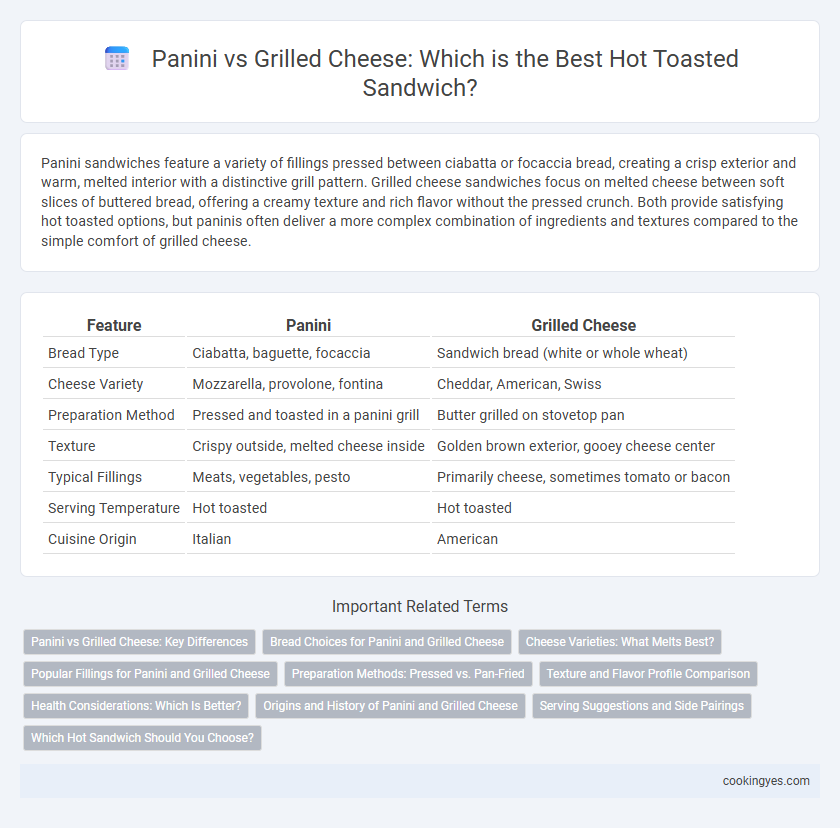Panini sandwiches feature a variety of fillings pressed between ciabatta or focaccia bread, creating a crisp exterior and warm, melted interior with a distinctive grill pattern. Grilled cheese sandwiches focus on melted cheese between soft slices of buttered bread, offering a creamy texture and rich flavor without the pressed crunch. Both provide satisfying hot toasted options, but paninis often deliver a more complex combination of ingredients and textures compared to the simple comfort of grilled cheese.
Table of Comparison
| Feature | Panini | Grilled Cheese |
|---|---|---|
| Bread Type | Ciabatta, baguette, focaccia | Sandwich bread (white or whole wheat) |
| Cheese Variety | Mozzarella, provolone, fontina | Cheddar, American, Swiss |
| Preparation Method | Pressed and toasted in a panini grill | Butter grilled on stovetop pan |
| Texture | Crispy outside, melted cheese inside | Golden brown exterior, gooey cheese center |
| Typical Fillings | Meats, vegetables, pesto | Primarily cheese, sometimes tomato or bacon |
| Serving Temperature | Hot toasted | Hot toasted |
| Cuisine Origin | Italian | American |
Panini vs Grilled Cheese: Key Differences
Panini sandwiches use ciabatta or baguette bread pressed and toasted with a panini grill, creating a crispy exterior and warm, melted fillings, often including meats, cheeses, and vegetables. Grilled cheese sandwiches traditionally feature sliced sandwich bread buttered and cooked on a skillet, focusing on gooey melted cheese with a golden-brown crust. The key differences lie in bread type, cooking technique, and texture, with paninis offering a pressed and crunchier bite, while grilled cheese emphasizes simplicity and creamy melted cheese.
Bread Choices for Panini and Grilled Cheese
Panini sandwiches traditionally use Italian bread varieties such as ciabatta or focaccia, offering a sturdy texture that crisps well under the press while maintaining a chewy interior. Grilled cheese sandwiches often utilize softer breads like white sandwich bread or sourdough, which brown evenly and create a gooey contrast with melted cheese. The bread's density and crust-to-crumb ratio directly influence the sandwich's structural integrity and moisture retention during toasting.
Cheese Varieties: What Melts Best?
Paninis often feature Italian cheeses like mozzarella, provolone, and fontina, prized for their smooth melting and creamy texture that complements the sandwich's crisp bread. Grilled cheese sandwiches typically rely on cheddar, American, or Monterey Jack, which offer a sharper flavor and robust melt ideal for achieving that classic gooey stretch. Both styles benefit from cheeses with high moisture content and good meltability, but paninis emphasize a balance of melt and flavor, while grilled cheese prioritizes rich, melty comfort.
Popular Fillings for Panini and Grilled Cheese
Popular fillings for panini often include Italian cured meats like prosciutto and salami, paired with fresh mozzarella, sun-dried tomatoes, and basil for a Mediterranean flavor profile. Grilled cheese sandwiches typically feature a variety of cheeses such as cheddar, American, or Gruyere, sometimes enhanced with additions like tomato slices, caramelized onions, or crispy bacon. Both sandwiches offer versatile fillings, with panini favoring deli meats and fresh vegetables, while grilled cheese focuses on melting cheeses and complementary savory ingredients.
Preparation Methods: Pressed vs. Pan-Fried
Panini sandwiches are prepared using a press that applies heat and pressure simultaneously, resulting in a crispy, evenly toasted exterior with melted fillings inside. Grilled cheese sandwiches are typically cooked in a pan, where bread slices are pan-fried with butter or oil, creating a golden-brown crust through direct contact with the hot surface. The pressing method of panini machines produces distinctive grill marks and a compact texture, while pan-frying allows for more control over browning and melting without compression.
Texture and Flavor Profile Comparison
Panini sandwiches offer a crispier, more evenly toasted texture due to their pressurized grilling, which enhances the caramelization of the bread and intensifies the sandwich's flavor complexity. Grilled cheese, characterized by its buttery, golden crust and melty, gooey interior, delivers a rich, creamy taste with a comforting softness in every bite. Both sandwiches provide distinct sensory experiences: paninis highlight a satisfying crunch and layered flavors, while grilled cheese emphasizes smoothness and a decadent, cheesy aroma.
Health Considerations: Which Is Better?
Panini and grilled cheese sandwiches differ notably in health considerations due to ingredients and preparation methods. Paninis often include lean proteins, vegetables, and whole-grain breads, offering a balanced mix of fiber and nutrients, while grilled cheese typically involves higher amounts of butter and processed cheese, increasing saturated fat content. Choosing a panini with fresh, nutrient-dense fillings generally supports better cardiovascular health compared to the calorie-dense, high-fat profile of traditional grilled cheese.
Origins and History of Panini and Grilled Cheese
The panini, originating from Italy, traditionally features ciabatta or baguette bread filled with cured meats, cheeses, and vegetables, pressed and toasted to achieve a warm, crispy texture. The grilled cheese sandwich, rooted in American cuisine, gained popularity during the 1920s when affordable processed cheese and sliced bread became widely available, making it a simple yet comforting comfort food. Both sandwiches have evolved into iconic toasted creations, with the panini emphasizing artisanal ingredients and the grilled cheese embodying nostalgic, gooey simplicity.
Serving Suggestions and Side Pairings
Panini sandwiches, typically pressed and toasted with fillings like mozzarella, tomatoes, and basil, pair excellently with crisp salads or roasted vegetables to balance their hearty texture. Grilled cheese, known for its melted cheese and buttery crust, complements creamy tomato soup or tangy pickles, enhancing the sandwich's rich flavors. Both sandwiches benefit from sides that contrast their warmth and texture, creating a satisfying and well-rounded meal experience.
Which Hot Sandwich Should You Choose?
Panini offers a crisp texture with varied fillings, often including Italian meats, cheeses, and vegetables pressed together for a balanced flavor profile. Grilled cheese highlights melted cheese between buttery toasted bread, delivering a simple, rich, and creamy taste ideal for comfort food lovers. Choose panini for a gourmet, flavorful experience or grilled cheese for classic, nostalgic satisfaction.
Panini vs Grilled cheese for hot toasted sandwich Infographic

 cookingyes.com
cookingyes.com